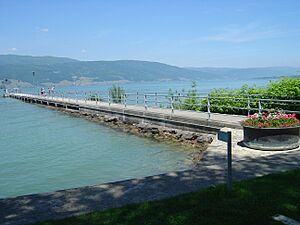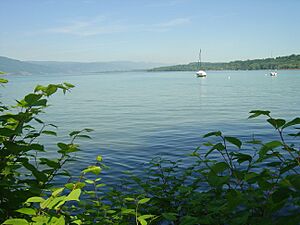Lüscherz facts for kids
Quick facts for kids
Lüscherz
|
||
|---|---|---|
|
||
| Country | Switzerland | |
| Canton | Bern | |
| District | Seeland | |
| Area | ||
| • Total | 5.42 km2 (2.09 sq mi) | |
| Elevation | 442 m (1,450 ft) | |
| Population
(Dec 2020 )
|
||
| • Total | 559 | |
| • Density | 103.14/km2 (267.1/sq mi) | |
| Postal code |
2576
|
|
| Surrounded by | Brüttelen, Finsterhennen, Hagneck, Ins, Siselen, Twann, Vinelz | |
Lüscherz is a small town, also called a municipality, located in the Seeland area of the canton of Bern in Switzerland. It's a charming place with a long history, especially connected to the nearby lake.
Contents
History of Lüscherz
Lüscherz was first written about in 1271 as Luschiers. However, people have lived in this area for a very long time, since at least the Neolithic period (around 3700 to 2700 BC). This was a time when people started farming and living in settled communities. The town was once known by its French name, Locras, but that name is not used anymore.
During the Neolithic era, there were two villages built on stilts along the shore of Lake Biel. These special stilt house settlements are now part of the Prehistoric Pile dwellings around the Alps, which is a UNESCO World Heritage Site. This means they are very important historical places protected by the world. The later of these two villages was even the center of a special culture called the Lüscherz culture.
These ancient sites are partly under water. But in the 1800s and 1900s, people dug up parts near the beach. They found many old tools and items, which are now in museums. Besides the Neolithic sites, a building from the Bronze Age was found in 2004. Also, several ancient burial mounds from the Hallstatt era were found in the hills above the village. Even older, a settlement from the late Paleolithic period (around 12,000 BC) was found on a ridge south of the village.
In the Late Middle Ages, there was another village called Gurzelen nearby. It was first mentioned in 1335. People also grew crops on terraces on the Feiberg hill. Over time, Gurzelen became smaller, and the terraces were not used as much. Lüscherz became part of the area ruled by Erlach. Then, in 1474, it came under the control of Bern.
Around 1470, the village started collecting money from people who came to visit a special chapel called the Chapel of St. Mary. This chapel was no longer used after 1528.
For a long time, most people in Lüscherz made a living by fishing. Some also farmed or grew grapes in vineyards. In the 1960s, Lüscherz started to become a popular place for vacations. A port and a beach resort opened in 1957, bringing in many tourists. The village grew as more vacation homes were built. While fishing and building boats were still important, tourism became a big part of the town's income. By 2000, many people living in Lüscherz traveled to jobs in bigger cities like Biel and Bern.
Geography of Lüscherz
Lüscherz covers an area of about 5.40 square kilometers (2.08 square miles). A large part of this land, about 44.3%, is used for farming. Forests cover another big part, about 45.8% of the area. The rest of the land is used for buildings and roads (7.7%), or it's covered by rivers and lakes (0.7%). A very small part (0.9%) is unproductive land.
Lüscherz is located on the right side of Lake Biel and at the bottom of a mountain called Feiberg. It also includes a part of the Grosses Moos, which is a very fertile area with dark soil in the Bernese Seeland. The Hagneck Canal also runs through the area. The municipality includes the main village of Lüscherz and a smaller settlement called Gurzelen.
Lüscherz Coat of Arms
The coat of arms for Lüscherz shows a silver plowshare (the blade of a plow) and a silver fish swimming at the top, all on a blue background.
People of Lüscherz (Demographics)
As of December 2011, Lüscherz had a population of 526 people. In 2010, about 9.2% of the people living there were foreign nationals. Over the past ten years (from 2000 to 2010), the population grew by about 7.9%. Most of this growth came from people moving into the town.
Most people in Lüscherz (about 94.3%) speak German as their main language. French is the second most common language (3.7%), followed by English (0.8%).
In 2008, about 52.9% of the population was male and 47.1% was female. Many people (about 35.6%) were born in Lüscherz and still lived there in 2000. Others were born in the same canton (37.8%) or elsewhere in Switzerland (16.1%). About 7.9% of the people were born outside of Switzerland.
In 2010, children and teenagers (ages 0–19) made up about 15.3% of the population. Adults (ages 20–64) were the largest group at 68.2%, and seniors (over 64 years old) made up 16.6%.
The population of Lüscherz has changed over the years. For example, in 1764, there were 227 people. By 1850, it had grown to 403. The population went down a bit in the early 1900s but started to grow again towards the end of the century. In 2000, there were 492 people.
Important Heritage Sites
The ancient Hallstatt era burial mounds at Schaltenrain and Grossholz are very important. They are listed as a Swiss heritage site of national significance. This means they are protected as important parts of Switzerland's history.
World Heritage Site in Lüscherz
Lüscherz is home to an important archeological site called Lüscherz-Dorfstation. This site has prehistoric pile-dwelling settlements, which are part of the Prehistoric Pile dwellings around the Alps UNESCO World Heritage Site.
The village on the lake shore at Lüscherz-Dorfstation was lived in twice during the neolithic era and once during the Bronze Age. It is thought to have been the main place for the Lüscherz culture, a group of people who lived there between 3900 BC and 3700 BC. This culture might have been a very early version of another group called the Horgen culture, but we don't know for sure.
This site was found in 1863. People started digging there, but it was stopped for a while. Later, in 1878, a doctor named V. Gross started digging again. Both sites were then left alone for almost 100 years. In 1954, the Historical Museum of Bern began new excavations before a harbor was built. The building of the harbor in the late 1950s unfortunately destroyed some parts of the ancient village.
The oldest settlement at the site was from the Neolithic period, around 3590/3580 BC. The second settlement, from the Lüscherz culture, has piles that have been dated to between 2792 and 2709 BC using tree rings. Some items from the Late Bronze Age were also found, likely from a village that was further out in the lake. We don't know much about that village.
Economy of Lüscherz
In 2008, there were 129 people working in Lüscherz. Many people worked in the primary economic sector, which includes farming and fishing. There were 48 people in this sector. Another 25 people worked in the secondary sector, which includes manufacturing and construction. The largest group, 56 people, worked in the tertiary sector. This sector includes jobs like sales, transportation, hotels, and restaurants. For example, 27 people worked in hotels or restaurants.
Many people who live in Lüscherz travel to other towns for work. In 2000, 183 people left Lüscherz to work elsewhere, while only 40 people came into Lüscherz for work. Most people (61.3%) used a private car to get to work, while 9.8% used public transportation.
Religion in Lüscherz
According to the 2000 census, most people in Lüscherz (75.0%) belonged to the Swiss Reformed Church. About 12.6% were Roman Catholic. A small number of people (2.44%) belonged to other Christian churches. About 9.55% of the population said they did not belong to any church, or were agnostic or atheist.
Education in Lüscherz
In Lüscherz, about 41.3% of the people have finished non-mandatory upper secondary education. This means they went to school beyond what was required. Also, about 12.8% have completed higher education, like attending a university or a specialized college (a Fachhochschule).
The school system in the Canton of Bern starts with one year of optional Kindergarten. After that, students go to six years of Primary school. Then, they have three years of required lower Secondary school, where students are grouped by their abilities. After lower Secondary, students can choose to continue their education or start an apprenticeship (learning a trade on the job).
During the 2010–11 school year, there were 49 students in Lüscherz schools. There was one kindergarten class with 17 students. The town also had two primary classes with 32 students.
In 2000, 37 students who lived in Lüscherz went to schools outside the municipality, while only 4 students from other towns came to school in Lüscherz.
Images for kids
See also
 In Spanish: Lüscherz para niños
In Spanish: Lüscherz para niños








